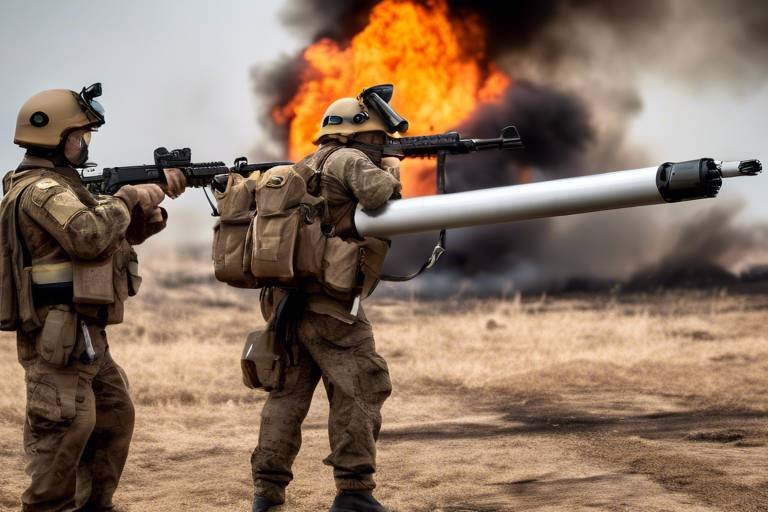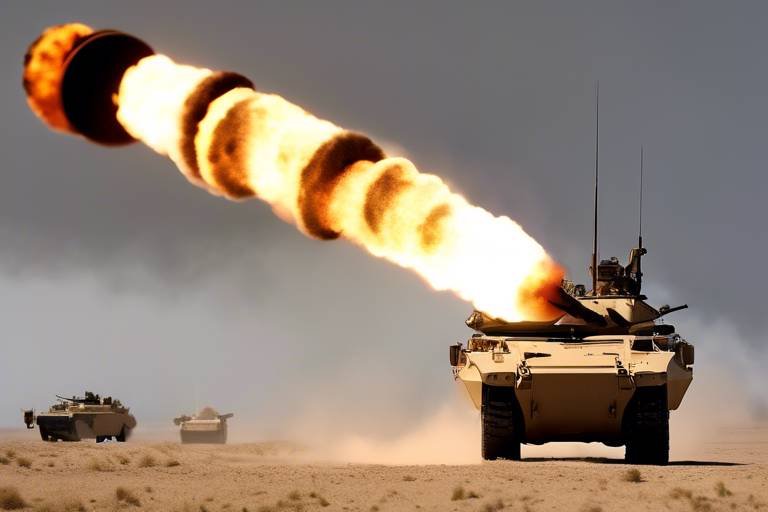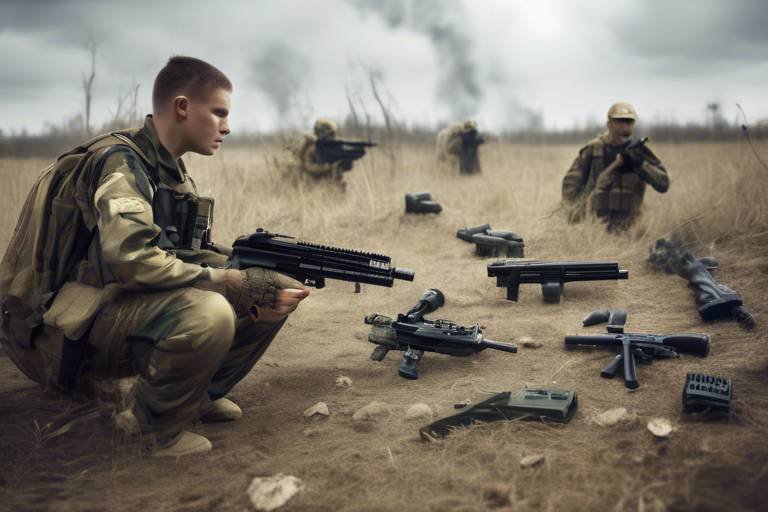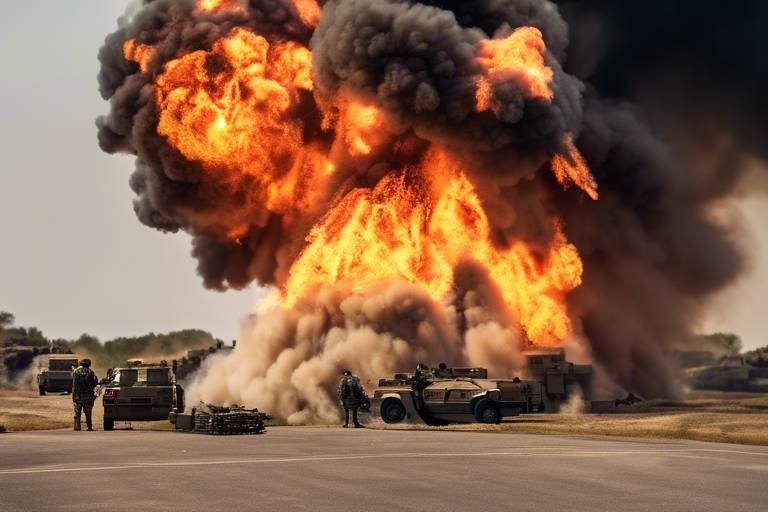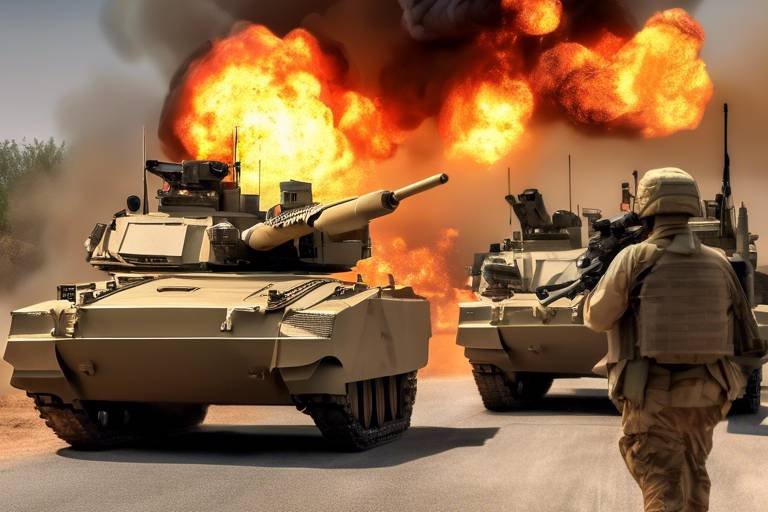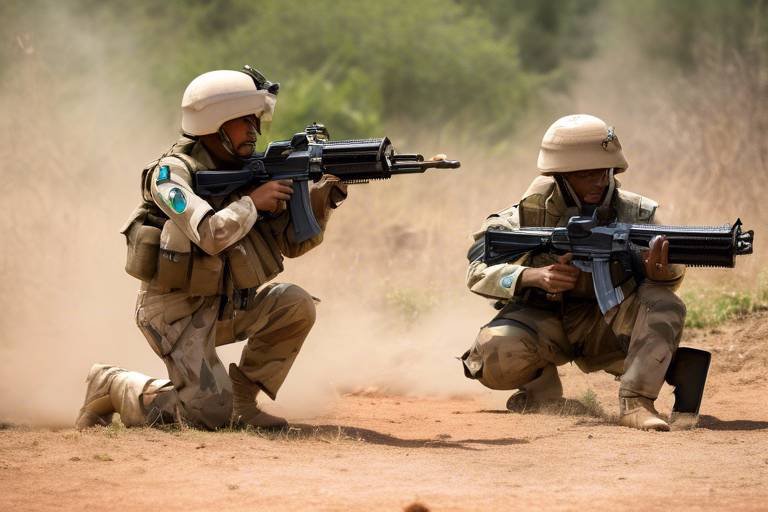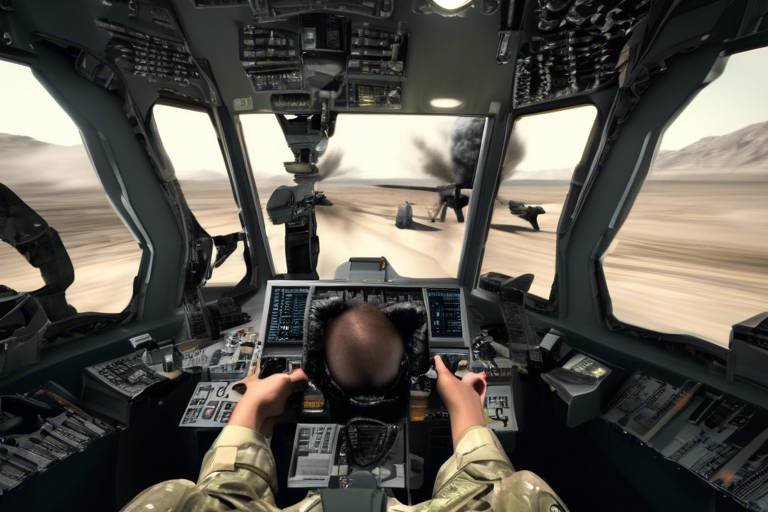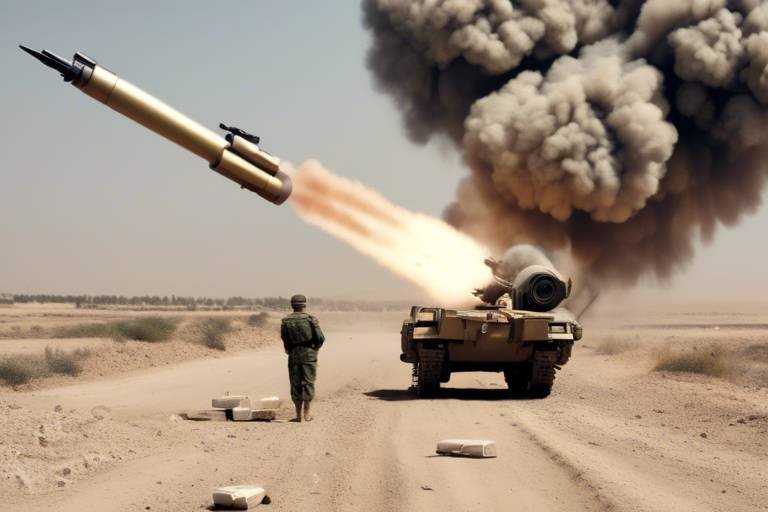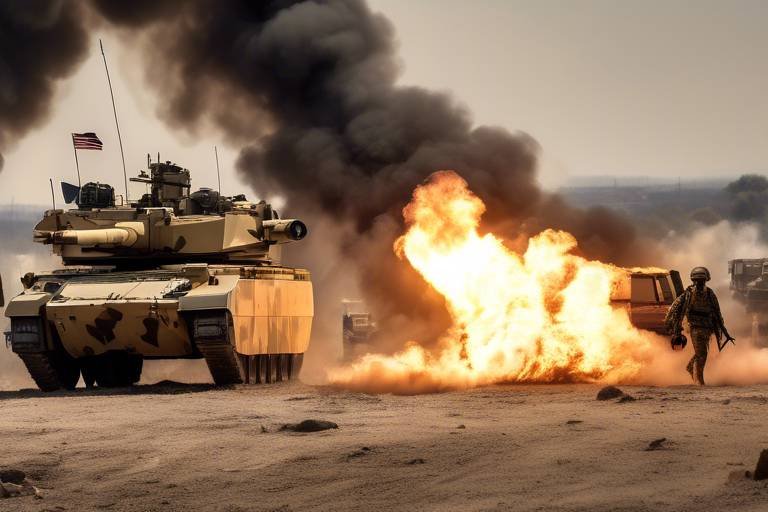The Use of Multi-Domain Operations in Coordinating Firepower
In the fast-evolving landscape of modern warfare, the concept of multi-domain operations has emerged as a game-changer. Imagine a battlefield where land, air, sea, space, and cyber capabilities work in perfect harmony, like a well-conducted orchestra. This integration is not just a tactical innovation; it’s a necessity for achieving operational success. Multi-domain operations enhance the coordination of firepower, allowing military forces to strike with precision and efficiency across various domains. As we delve deeper into this topic, we'll uncover how these operations are reshaping military strategies and enhancing the effectiveness of firepower deployment.
At its core, multi-domain operations involve the seamless integration of diverse military capabilities. Think of it as a complex puzzle where each piece represents a different domain—land, air, sea, space, and cyber. When these pieces fit together, they create a comprehensive picture of operational capability. This approach not only enhances strategic advantages but also provides operational flexibility that is crucial in today’s fast-paced combat environments. By leveraging the strengths of each domain, military forces can execute coordinated strikes that are more effective than traditional, domain-specific operations.
Effective coordination among various military branches is the backbone of successful operations. Without it, even the most advanced technology and weaponry can fall short. Multi-domain operations foster improved communication and collaboration, enabling forces to synchronize their efforts. For instance, when ground troops coordinate with air support, they can deploy firepower more effectively, minimizing collateral damage and maximizing impact. This level of coordination is vital for ensuring that every asset is utilized to its fullest potential, leading to a more cohesive and powerful military response.
However, the road to effective coordination is fraught with challenges. Inter-service rivalry can create friction, as each branch may have its own priorities and operational philosophies. Additionally, communication barriers can hinder the flow of information, making it difficult for units to work together seamlessly. The complexity of integrating diverse technologies further complicates the situation. For example, different branches may use incompatible systems that fail to communicate effectively, leading to delays and miscommunications. Addressing these challenges is essential for unlocking the full potential of multi-domain operations.
Fortunately, emerging technologies are stepping up to address these coordination challenges. Innovations such as artificial intelligence (AI), advanced communication systems, and data analytics are transforming the way military forces operate. AI can assist in real-time decision-making, analyzing vast amounts of data to provide actionable insights. Advanced communication systems ensure that information flows smoothly between units, regardless of their domain. Data analytics can help in predicting outcomes and optimizing resource allocation. Together, these technologies create a more integrated and responsive military force.
To fully leverage multi-domain operations, developing effective training programs and doctrines is crucial. Joint exercises that simulate multi-domain scenarios can prepare military personnel for the complexities of integrated operations. These training initiatives not only enhance individual skills but also foster a culture of collaboration among different branches. Educational programs that emphasize the importance of multi-domain operations can further equip personnel with the knowledge and skills needed to thrive in this new operational landscape.
Real-world examples provide compelling evidence of the effectiveness of multi-domain operations. For instance, during recent conflicts, forces that employed multi-domain strategies achieved superior mission outcomes compared to those that operated within traditional frameworks. These case studies highlight the importance of coordination and the impact it has on overall operational success. They serve as valuable lessons for future military engagements, demonstrating that the integration of capabilities across domains is not just advantageous; it is essential for modern warfare.
As warfare continues to evolve, so too do the strategies surrounding multi-domain operations. Anticipated trends include an increased reliance on unmanned systems, cyber warfare capabilities, and the growing significance of space as a military domain. Unmanned systems, such as drones, offer new avenues for surveillance and strike capabilities, allowing forces to operate with reduced risk to personnel. Meanwhile, cyber warfare is becoming a critical component of military strategy, as adversaries increasingly target information systems. The domain of space is also gaining prominence, with nations recognizing its strategic importance in modern conflict.
The integration of multi-domain operations into military strategy has profound implications. It reshapes strategic planning, resource allocation, and the overall approach to modern warfare. Military leaders must now consider how to effectively deploy assets across multiple domains to achieve their objectives. This shift requires a reevaluation of existing doctrines and the development of new strategies that embrace the complexities of multi-domain environments.
Finally, the need for international cooperation in multi-domain operations is becoming increasingly apparent. As global security challenges grow, allied forces must collaborate effectively to enhance collective firepower. Joint exercises and multinational training programs can foster interoperability and build trust among partner nations. By working together, allies can address shared security challenges and create a more formidable response to potential threats.
- What are multi-domain operations? Multi-domain operations involve the integration of land, air, sea, space, and cyber capabilities to enhance military effectiveness.
- Why is coordination important in military operations? Effective coordination ensures that military forces can work together seamlessly, maximizing the impact of their firepower.
- What challenges do multi-domain operations face? Challenges include inter-service rivalry, communication barriers, and the complexity of integrating diverse technologies.
- How are emerging technologies helping in multi-domain operations? Technologies like AI and advanced communication systems enhance real-time decision-making and operational integration.
- What is the future of multi-domain operations? Future trends include increased reliance on unmanned systems and the growing significance of cyber warfare and space as military domains.
Understanding Multi-Domain Operations
In today's rapidly evolving battlefield, multi-domain operations (MDO) have emerged as a game-changing strategy, allowing military forces to harness the full spectrum of their capabilities. But what exactly does this mean? At its core, MDO is about integrating various military domains—land, air, sea, space, and cyber—into a cohesive operational framework. Imagine a symphony orchestra, where each instrument plays its part in harmony to create a beautiful piece of music. In the same way, MDO enables different military branches to work together seamlessly, enhancing strategic advantages and ensuring operational flexibility.
The essence of MDO lies in its ability to synchronize actions across these diverse domains. For instance, consider a scenario where ground troops are engaged in combat. With MDO, air support can be coordinated in real-time, while cyber capabilities might be deployed to disrupt enemy communications. This level of integration not only optimizes the use of firepower but also increases the chances of mission success. The ability to operate across multiple domains allows military leaders to respond swiftly to changing situations, much like a chess player who can anticipate and counter their opponent's moves.
Moreover, MDO is not just about technology; it also encompasses the human element. Effective communication and collaboration among different military branches are essential for success. This requires a shift in mindset, where personnel are trained to think beyond their traditional roles and embrace a more holistic approach to warfare. By fostering a culture of cooperation, military forces can ensure that they are not just a collection of individual units, but a unified entity capable of achieving common goals.
As we delve deeper into the intricacies of multi-domain operations, it becomes clear that this approach is not without its challenges. The complexity of integrating diverse technologies and overcoming inter-service rivalry can hinder effective coordination. However, by leveraging emerging technologies and investing in joint training programs, military forces can enhance their operational capabilities and better prepare for the complexities of modern warfare.
In summary, understanding MDO is crucial for grasping the future of military operations. It represents a shift towards a more integrated and flexible approach, where the combined strength of various domains can be leveraged to achieve strategic objectives. As we continue to explore this topic, we'll uncover how MDO not only enhances firepower but also reshapes the landscape of warfare itself.
The Importance of Coordination
This article explores the significance of multi-domain operations in modern warfare, focusing on how they enhance coordination, efficiency, and effectiveness in utilizing firepower across various military domains.
Multi-domain operations involve the integration of land, air, sea, space, and cyber capabilities. This approach allows military forces to operate seamlessly across different environments, enhancing strategic advantages and operational flexibility.
In the realm of military operations, coordination is not just a buzzword; it's the backbone of successful missions. Imagine trying to assemble a complex puzzle without knowing where each piece fits. That's what uncoordinated military actions feel like—disjointed and ineffective. When various military branches work in silos, the potential for maximizing firepower diminishes significantly. By adopting multi-domain operations, forces can synchronize their efforts, leading to a more unified approach to warfare.
Effective coordination among different military branches is crucial for successful operations. It ensures that every unit, whether on land, in the air, or at sea, is moving in harmony towards a common goal. This synergy not only improves communication but also enhances collaboration, allowing for a more synchronized and effective use of firepower. For instance, when ground troops are supported by aerial bombardments or naval artillery, the impact is far greater than if these forces acted independently. This interdependence is what makes multi-domain operations so powerful.
Moreover, coordination in multi-domain operations can lead to the following benefits:
- Increased Efficiency: Resources are utilized more effectively when all branches are aligned, reducing waste and maximizing impact.
- Enhanced Situational Awareness: Real-time data sharing among units leads to better decision-making and quicker responses to emerging threats.
- Improved Tactical Flexibility: Forces can adapt to changing battlefield conditions more rapidly when they are well-coordinated.
However, achieving this level of coordination is not without its challenges. Different branches often have their own cultures, priorities, and operational methods. Bridging these gaps requires a concerted effort and a shift in mindset. Military leaders must prioritize joint training and exercises that foster inter-service cooperation. Only then can they develop a cohesive strategy that effectively employs multi-domain operations.
In conclusion, the importance of coordination in multi-domain operations cannot be overstated. It is the linchpin that holds together the various elements of modern warfare, ensuring that military forces can operate not just effectively but also efficiently. As we move forward, embracing this concept will be essential for any military seeking to maintain a competitive edge in the ever-evolving landscape of warfare.
Despite advancements, coordinating multi-domain operations presents several challenges. This subsection examines common obstacles, including inter-service rivalry, communication barriers, and the complexity of integrating diverse technologies.
Emerging technologies play a vital role in overcoming coordination challenges. This segment highlights innovations such as AI, advanced communication systems, and data analytics that enhance real-time decision-making and operational integration.
Developing effective training programs and doctrines is essential for successful multi-domain operations. This part discusses the importance of joint exercises and educational initiatives to prepare military personnel for integrated operations.
Real-world examples illustrate the effectiveness of multi-domain operations. This section presents notable case studies that demonstrate successful coordination and the impact on mission outcomes in various conflicts.
As warfare evolves, so do multi-domain operations. This section explores anticipated trends, including increased reliance on unmanned systems, cyber warfare capabilities, and the growing significance of space as a military domain.
The integration of multi-domain operations into military strategy has profound implications. This subsection discusses how these operations reshape strategic planning, resource allocation, and the overall approach to modern warfare.
The need for international cooperation in multi-domain operations is becoming increasingly apparent. This part examines how allied forces can collaborate effectively to enhance collective firepower and address shared security challenges.
Q: What are multi-domain operations?
A: Multi-domain operations refer to military strategies that integrate capabilities across land, air, sea, space, and cyber domains to achieve a synchronized approach to warfare.
Q: Why is coordination important in military operations?
A: Coordination ensures that different military branches work together effectively, maximizing the use of firepower and improving overall mission success.
Q: What challenges exist in achieving coordination?
A: Common challenges include inter-service rivalry, communication barriers, and the complexity of integrating diverse technologies.
Q: How can technology aid in coordination?
A: Technologies such as AI, advanced communication systems, and data analytics can enhance real-time decision-making and operational integration, facilitating better coordination.
Q: What role does training play in multi-domain operations?
A: Training programs and joint exercises are crucial for preparing military personnel to operate effectively in a multi-domain environment, fostering collaboration among different branches.
Challenges in Coordination
In the realm of multi-domain operations, coordination is not just a buzzword—it's a necessity. However, the path to seamless integration across land, air, sea, space, and cyber domains is fraught with challenges. Imagine trying to orchestrate a symphony where each musician plays a different tune; that’s often how military coordination can feel. The complexity involved in aligning various branches of the military can be overwhelming, especially when they all have different cultures, priorities, and operational procedures.
One of the most significant hurdles in achieving effective coordination is inter-service rivalry. Each branch of the military—be it the Army, Navy, Air Force, or Marines—has its own distinct identity and mission. This can lead to a competitive atmosphere rather than a collaborative one, where each service may prioritize its own objectives over a unified approach. Such rivalry can stall decision-making processes and lead to inefficiencies in deploying firepower where it is needed most.
Another challenge is the communication barriers that arise from using different technologies and protocols. Picture a group of friends trying to plan a vacation but speaking different languages; that’s what can happen when various military branches attempt to coordinate their efforts. The lack of a common communication framework can result in critical information being lost or misinterpreted, which could have dire consequences in high-stakes situations.
Additionally, the complexity of integrating diverse technologies cannot be understated. Each military domain utilizes specialized tools and systems, and merging these into a cohesive operational framework is no small feat. For instance, the data from a satellite might need to be relayed to ground troops in real-time, but if the systems don’t communicate effectively, that vital information may never reach its destination. This integration challenge requires not only technological solutions but also a cultural shift within the military to embrace a more unified approach.
To summarize the challenges, consider the following table that outlines the key obstacles faced in coordinating multi-domain operations:
| Challenge | Description |
|---|---|
| Inter-Service Rivalry | Competition between military branches can hinder collaboration. |
| Communication Barriers | Diverse technologies and protocols lead to miscommunication. |
| Technological Integration | Difficulty in merging various operational systems hampers effectiveness. |
In conclusion, while the potential for enhanced operational effectiveness through multi-domain operations is enormous, overcoming these coordination challenges is crucial. Without addressing these issues, the military risks losing the very advantages that multi-domain operations are designed to provide. As we look forward, focusing on solutions to these challenges will be essential for the success of future military endeavors.
- What are multi-domain operations? Multi-domain operations integrate capabilities across land, air, sea, space, and cyber domains to enhance military effectiveness.
- Why is coordination important in multi-domain operations? Effective coordination ensures that all military branches work together seamlessly, maximizing the use of firepower and resources.
- What are some common challenges in coordinating multi-domain operations? Challenges include inter-service rivalry, communication barriers, and the complexity of integrating diverse technologies.
Technological Solutions
In the realm of multi-domain operations, technology is not just a tool; it's the lifeblood that fuels the coordination and effectiveness of military strategies. As we dive into this exciting world, it's essential to recognize how emerging technologies are revolutionizing the way armed forces communicate, collaborate, and execute their missions. Imagine a symphony where each instrument plays in perfect harmony; that's what tech-driven coordination aims to achieve in military operations.
One of the most significant breakthroughs has been the advent of Artificial Intelligence (AI). AI systems can analyze vast amounts of data in real-time, providing commanders with actionable insights that were previously unimaginable. Picture this: a battlefield scenario where AI predicts enemy movements based on historical data and current troop placements. This predictive capability allows for more proactive strategies and faster decision-making, ultimately leading to a more effective use of firepower.
Moreover, advanced communication systems have emerged as game-changers in multi-domain operations. These systems facilitate seamless communication between different branches of the military, breaking down the silos that often hinder collaboration. For instance, consider a scenario where ground troops require air support. With cutting-edge communication technology, they can instantly relay their needs to air units, ensuring that firepower is deployed precisely when and where it's needed. This kind of agility is critical in modern warfare.
Additionally, data analytics plays a pivotal role in enhancing operational integration. By leveraging big data, military leaders can identify patterns, assess risks, and allocate resources more efficiently. Imagine a command center equipped with dashboards that visualize real-time data from various domains—land, air, sea, and cyber. This holistic view empowers decision-makers to coordinate firepower across all fronts, ensuring a synchronized approach to combat.
However, the implementation of these technological solutions is not without its challenges. Interoperability remains a significant concern, as different branches often use disparate systems that do not easily communicate with one another. To address this, military organizations are investing in joint training programs that familiarize personnel with various technologies and ensure that everyone is on the same page. After all, what's the point of having cutting-edge tools if the people using them can't effectively collaborate?
As we look to the future, the integration of these technological solutions will undoubtedly shape the landscape of multi-domain operations. The military's ability to adapt and embrace innovation will determine its effectiveness in a rapidly evolving battlefield. In essence, technology is not just enhancing operational capabilities; it's redefining the very nature of warfare itself.
- What are multi-domain operations?
Multi-domain operations refer to the coordinated use of land, air, sea, space, and cyber capabilities to achieve military objectives.
- How does technology enhance multi-domain operations?
Technology, such as AI and advanced communication systems, improves coordination, decision-making, and the overall effectiveness of military strategies.
- What are the challenges faced in coordinating multi-domain operations?
Challenges include inter-service rivalry, communication barriers, and the complexity of integrating diverse technologies.
- Why is training important for multi-domain operations?
Training ensures that military personnel are well-versed in using various technologies and can work together effectively during operations.
Training and Doctrine Development
In the realm of multi-domain operations, effective training and doctrine development are not just important—they're absolutely essential. Think of it like preparing a symphony orchestra: without the right training and a well-crafted score, even the most talented musicians can struggle to produce a harmonious sound. Similarly, military personnel need to be well-versed in the intricacies of operating across various domains to ensure seamless coordination and execution of their missions.
One of the key components of this training is the emphasis on joint exercises that simulate real-world scenarios. These exercises allow different military branches to practice working together in a controlled environment, fostering a culture of collaboration and improving their ability to respond to dynamic situations. For instance, during a joint exercise, air force pilots might work alongside ground troops to coordinate airstrikes that maximize effectiveness while minimizing collateral damage. This not only enhances the operational capabilities of each branch but also builds trust and understanding among the forces.
Moreover, the development of comprehensive doctrines is crucial. Doctrines serve as the guiding principles for military operations, outlining how forces should be organized and employed in various scenarios. In the context of multi-domain operations, doctrines must evolve to reflect the growing complexity of warfare. This includes integrating emerging technologies such as artificial intelligence and cyber capabilities, which are becoming increasingly pivotal in modern combat. Military leaders must ensure that these doctrines are not static; they should be living documents that adapt to new threats and opportunities.
To illustrate the importance of training and doctrine development, consider the following table that outlines the essential elements for successful multi-domain operations:
| Element | Description |
|---|---|
| Joint Exercises | Simulated operations that foster inter-service collaboration and enhance real-world readiness. |
| Comprehensive Doctrines | Guiding principles that shape how forces operate across multiple domains, adapting to new technologies and threats. |
| Continuous Education | Ongoing training programs that keep personnel up-to-date with the latest strategies and technologies. |
| Feedback Mechanisms | Systems in place to gather insights from exercises and real operations, ensuring continuous improvement. |
Additionally, fostering a culture of innovation within military ranks is vital. Encouraging personnel to think outside the box and propose new ideas can lead to breakthroughs in how operations are conducted. This innovative spirit can be cultivated through workshops, seminars, and collaborative projects that bring together experts from various fields. By sharing knowledge and experiences, military forces can develop more effective strategies for multi-domain operations.
In conclusion, the success of multi-domain operations hinges on robust training programs and well-developed doctrines. By investing in these areas, military forces can enhance their preparedness, ensuring that they are not only ready to face current challenges but also adaptable to future ones. As the landscape of warfare continues to evolve, so too must the training and doctrines that guide our military personnel.
- What are multi-domain operations? Multi-domain operations refer to the integration of land, air, sea, space, and cyber capabilities to enhance military effectiveness.
- Why is coordination important in multi-domain operations? Effective coordination ensures that different military branches work together seamlessly, maximizing the impact of firepower and resources.
- How do joint exercises contribute to multi-domain operations? Joint exercises simulate real-world scenarios, allowing different branches to practice collaboration and improve their operational readiness.
- What role do doctrines play in multi-domain operations? Doctrines provide guiding principles for how forces should operate across various domains, adapting to new technologies and evolving threats.
Case Studies of Multi-Domain Operations
When we talk about multi-domain operations, it’s not just a buzzword thrown around in military circles; it’s a proven strategy that has reshaped how modern warfare is conducted. Let’s dive into some remarkable case studies that showcase the effectiveness of this approach. One of the most notable examples comes from the 2016 NATO Exercise Trident Juncture, which brought together land, air, and naval forces from various allied nations. This exercise was not just a show of force; it was a demonstration of how synchronized operations across different domains can lead to superior outcomes. Through realistic scenarios that included cyber threats and information warfare, participants were able to practice coordination in a way that mirrored real-world challenges.
Another compelling case study is the 2017 Syrian Civil War, where the U.S. and its allies employed multi-domain strategies to combat ISIS. In this conflict, airstrikes were coordinated with ground operations, while cyber capabilities were utilized to disrupt enemy communications and logistics. The integration of these domains not only increased the effectiveness of firepower but also minimized collateral damage. It’s fascinating to see how the use of drones for intelligence, surveillance, and reconnaissance (ISR) provided real-time data that informed ground troops, leading to a more agile response to evolving battlefield dynamics.
Moreover, the 2020 Nagorno-Karabakh conflict between Armenia and Azerbaijan serves as a recent illustration of multi-domain operations in action. Azerbaijan’s use of drones and electronic warfare showcased the power of integrating air and cyber capabilities, which ultimately shifted the balance in favor of Azerbaijani forces. The conflict highlighted how modern warfare is increasingly reliant on technology and the need for military forces to adapt quickly to new tools and tactics. This case study emphasizes the necessity of training and preparation for military personnel to effectively engage in multi-domain operations.
To further understand the impact of these operations, consider the following table that summarizes key aspects of the case studies mentioned:
| Case Study | Key Domains Integrated | Outcome |
|---|---|---|
| NATO Exercise Trident Juncture (2016) | Land, Air, Sea, Cyber | Enhanced coordination among allied forces |
| Syrian Civil War (2017) | Air, Ground, Cyber | Effective combat against ISIS with minimal collateral damage |
| Nagorno-Karabakh Conflict (2020) | Air, Cyber | Shifted battlefield dynamics in favor of Azerbaijan |
These case studies not only illustrate the tangible benefits of multi-domain operations but also highlight the importance of continuous learning and adaptation in military strategy. As we move forward, it’s critical for armed forces around the world to embrace this integrated approach, ensuring that they are prepared for the complexities of modern warfare.
In conclusion, the success of multi-domain operations relies heavily on collaboration and the ability to leverage diverse capabilities. By examining these real-world examples, we can glean valuable insights that inform future strategies and enhance overall military effectiveness.
- What are multi-domain operations? Multi-domain operations refer to the integration of land, air, sea, space, and cyber capabilities to conduct military operations more effectively.
- Why are coordination and communication important in multi-domain operations? Effective coordination and communication among different military branches ensure synchronized efforts, leading to more efficient and successful operations.
- What challenges do military forces face in implementing multi-domain operations? Challenges include inter-service rivalry, communication barriers, and the complexity of integrating diverse technologies.
- How can emerging technologies improve multi-domain operations? Technologies such as AI, advanced communication systems, and data analytics can enhance real-time decision-making and operational integration.
Future Trends in Multi-Domain Operations
As we look to the horizon of military strategy, the landscape of warfare is rapidly evolving, especially in the realm of multi-domain operations (MDO). This evolution is not just a passing trend; it’s a fundamental shift that redefines how military forces engage in conflict. One of the most significant trends is the increased reliance on unmanned systems, which are becoming indispensable in modern combat scenarios. These systems, from drones to autonomous ground vehicles, allow for enhanced reconnaissance, targeting, and even strike capabilities without putting human lives at risk. Imagine sending a drone into a hostile area to gather intelligence while keeping your personnel safely at a distance—this is the future we are stepping into.
Another critical aspect of future MDO is the growing significance of cyber warfare capabilities. As our dependence on technology increases, so does the need to protect and exploit cyber domains. Future military operations will likely see an integrated approach where cyber capabilities are not just an afterthought but a core component of operational planning. This means that military leaders will need to think about how to defend their networks while simultaneously seeking to disrupt enemy communications and command structures. The battlefield of the future will be as much about digital dominance as it is about physical presence.
Moreover, the expansion of space as a military domain cannot be overlooked. With nations racing to establish their presence in space, the military implications are profound. Future operations will likely incorporate satellite technology for navigation, communication, and reconnaissance. The ability to leverage space assets will provide a strategic advantage, allowing for real-time data collection and analysis that can inform ground operations. As we continue to explore the cosmos, the military will need to develop new doctrines and strategies to ensure that space remains a secure and operationally advantageous domain.
In addition to these technological advancements, the future of MDO will also be shaped by international collaboration. As global threats become more complex and interconnected, allied forces will need to work together more effectively than ever before. This collaboration will involve sharing intelligence, resources, and technologies to enhance collective firepower. The pooling of resources can lead to a more synchronized response to threats, effectively multiplying the impact of each nation’s capabilities. In this context, joint exercises and multinational training programs will become essential for fostering interoperability among allied forces.
To summarize, the future of multi-domain operations is set to be characterized by:
- Unmanned systems: Increasing use of drones and autonomous vehicles in combat.
- Cyber warfare: Greater focus on integrating cyber capabilities into military strategies.
- Space operations: Enhanced reliance on satellite technology for operational success.
- International collaboration: Strengthened alliances to address global security challenges.
Each of these trends presents both opportunities and challenges for military strategists. As we embrace these advancements, the military must also remain vigilant about the potential risks and ethical considerations that come with new technologies. The battlefield of the future will undoubtedly be more complex, requiring a holistic approach that integrates all domains of warfare.
Q: What are multi-domain operations?
A: Multi-domain operations refer to the integration of land, air, sea, space, and cyber capabilities to conduct military operations more effectively across different environments.
Q: Why are unmanned systems important in future warfare?
A: Unmanned systems reduce the risk to human life and enhance operational capabilities by allowing for reconnaissance, targeting, and strike missions without direct human involvement on the battlefield.
Q: How does cyber warfare impact military strategy?
A: Cyber warfare impacts military strategy by necessitating the protection of critical networks while also providing opportunities to disrupt enemy communications and command structures.
Q: What role does international collaboration play in multi-domain operations?
A: International collaboration enhances collective firepower and allows allied forces to share intelligence, resources, and technologies, resulting in a more synchronized response to global threats.
Implications for Military Strategy
As the landscape of warfare continues to evolve, the integration of multi-domain operations into military strategy is not just a trend; it's a necessity. This shift significantly reshapes how military planners approach strategic objectives, resource allocation, and operational execution. In a world where threats can emerge from any domain—land, air, sea, space, or cyber—military forces must adapt to a more interconnected and complex operational environment.
One of the most profound implications of multi-domain operations is the need for a holistic view of warfare. Military strategists are increasingly required to consider how actions in one domain can impact others. For example, a successful airstrike might not only neutralize a target but could also disrupt enemy communications, thereby enhancing ground operations. This interconnectedness demands a shift from traditional, domain-specific thinking to a more integrated approach, where every military action is viewed through the lens of its potential multi-domain effects.
Moreover, the resource allocation process is evolving. With the advent of advanced technologies such as artificial intelligence and big data analytics, military leaders can now make more informed decisions about where to allocate resources. This capability allows for a more dynamic response to threats, ensuring that forces are positioned effectively across all domains. For instance, if intelligence indicates an imminent cyber attack, resources can be swiftly redirected to bolster cyber defenses without compromising overall operational readiness.
Additionally, multi-domain operations emphasize the importance of joint training and collaboration among different military branches. This collaboration fosters a culture of interoperability, where forces are not only familiar with their own capabilities but also understand how to work effectively with others. Regular joint exercises that simulate multi-domain scenarios can prepare personnel to respond more effectively to real-world situations, enhancing overall mission success rates.
However, this shift also presents challenges that military strategists must address. As forces integrate more closely across domains, issues such as inter-service rivalry and communication barriers can arise. Overcoming these obstacles requires a commitment to building a unified military culture that prioritizes collective success over individual branch achievements. The development of doctrines and policies that promote unity of effort is essential for fostering this collaborative environment.
In conclusion, the implications of multi-domain operations for military strategy are profound and far-reaching. As nations continue to adapt to the complexities of modern warfare, embracing a multi-domain approach will be crucial for achieving strategic objectives. The ability to operate seamlessly across various domains not only enhances operational effectiveness but also ensures that military forces are prepared to face the challenges of tomorrow.
- What are multi-domain operations?
Multi-domain operations refer to military strategies that integrate capabilities across land, air, sea, space, and cyber domains to enhance operational effectiveness and adaptability. - Why are multi-domain operations important?
They provide a strategic advantage by allowing military forces to coordinate efforts across different environments, leading to more effective responses to threats. - What challenges do multi-domain operations face?
Common challenges include inter-service rivalry, communication barriers, and the complexities of integrating diverse technologies. - How can technology assist in multi-domain operations?
Emerging technologies such as AI, advanced communication systems, and data analytics can improve real-time decision-making and enhance operational integration. - What role does training play in multi-domain operations?
Effective training programs and joint exercises are crucial for preparing military personnel to operate cohesively across multiple domains.
International Collaboration and Multi-Domain Operations
In the ever-evolving landscape of modern warfare, international collaboration has become not just beneficial, but essential for the success of multi-domain operations. As military conflicts increasingly span across land, air, sea, space, and cyber domains, the ability to work together with allied forces can significantly enhance a nation’s operational capabilities. Imagine a well-orchestrated symphony where each musician plays their part flawlessly; that’s the kind of synergy that international collaboration aims to achieve in military operations.
When countries unite their resources, skills, and technologies, they create a formidable force that can respond to threats more effectively. For instance, consider how NATO operates: member nations share intelligence, conduct joint training exercises, and develop interoperable systems that allow for seamless communication and coordination during operations. This kind of collaboration not only strengthens individual nations but also bolsters collective security.
However, the path to effective international collaboration is fraught with challenges. Differences in military doctrine, cultural approaches to warfare, and varying levels of technological advancement can complicate efforts. To address these issues, it’s crucial for nations to engage in regular joint exercises and training programs that foster mutual understanding and trust. These initiatives can serve as a platform for partners to learn from each other and refine their strategies for multi-domain operations.
Moreover, the integration of advanced technologies plays a pivotal role in enhancing international collaboration. For instance, cloud-based systems and secure communication networks enable real-time data sharing among allied forces. This not only improves situational awareness but also allows for rapid decision-making in the heat of battle. The table below illustrates some of the key technologies that facilitate international collaboration in multi-domain operations:
| Technology | Description | Benefit |
|---|---|---|
| Secure Communication Networks | Encrypted channels for data exchange | Enhances operational security |
| Cloud-Based Systems | Centralized data storage and access | Facilitates real-time information sharing |
| AI and Data Analytics | Automated data processing and insights | Improves decision-making speed |
Furthermore, the importance of joint military exercises cannot be overstated. These exercises provide a critical opportunity for forces to practice multi-domain operations in a controlled environment, allowing them to identify weaknesses and improve their collaborative tactics. By simulating real-world scenarios, military personnel can develop the skills necessary to operate seamlessly alongside their international partners.
As nations increasingly face shared security challenges, the need for robust international collaboration in multi-domain operations will only grow. Whether it’s combating terrorism, responding to cyber threats, or addressing territorial disputes, the ability to coordinate effectively across multiple domains can make all the difference in mission success. In essence, international collaboration in multi-domain operations is akin to a well-choreographed dance; it requires precision, timing, and an understanding of each participant's strengths to achieve a harmonious outcome.
In conclusion, as we look to the future of warfare, the integration of international collaboration in multi-domain operations will be paramount. By fostering strong partnerships, leveraging advanced technologies, and engaging in extensive training, nations can enhance their military effectiveness and ensure a united front against emerging threats.
- What are multi-domain operations? Multi-domain operations refer to military strategies that integrate land, air, sea, space, and cyber capabilities to enhance operational effectiveness.
- Why is international collaboration important in military operations? It enhances resource sharing, improves communication, and allows for a more coordinated response to threats, ultimately increasing mission success rates.
- How do technologies facilitate international military collaboration? Technologies such as secure communication networks and cloud-based systems enable real-time information sharing and improve situational awareness among allied forces.
Frequently Asked Questions
- What are multi-domain operations?
Multi-domain operations refer to the military strategy that integrates capabilities across various domains, including land, air, sea, space, and cyber. This approach allows for enhanced coordination and effectiveness in military operations, enabling forces to respond swiftly and flexibly to dynamic threats.
- Why is coordination important in multi-domain operations?
Coordination is crucial because it ensures that different military branches can work together efficiently. By improving communication and collaboration, multi-domain operations lead to more synchronized and effective use of firepower, ultimately increasing the chances of mission success.
- What challenges exist in coordinating multi-domain operations?
There are several challenges, including inter-service rivalry, communication barriers, and the complexity of integrating diverse technologies. These obstacles can hinder the seamless execution of operations and require innovative solutions to overcome.
- How do emerging technologies help in multi-domain operations?
Emerging technologies, such as artificial intelligence, advanced communication systems, and data analytics, play a vital role in enhancing real-time decision-making and operational integration. These innovations help military forces to overcome coordination challenges and improve overall effectiveness.
- What role does training play in multi-domain operations?
Training is essential for preparing military personnel for integrated operations. Effective training programs and joint exercises help develop the skills necessary for successful coordination across different domains, ensuring that forces are ready to respond to complex scenarios.
- Can you provide examples of successful multi-domain operations?
Yes, real-world case studies illustrate the effectiveness of multi-domain operations. These examples showcase successful coordination among various military branches and highlight the positive impact on mission outcomes in different conflicts.
- What are the future trends in multi-domain operations?
Future trends include an increased reliance on unmanned systems, advancements in cyber warfare capabilities, and the growing significance of space as a military domain. These trends will shape how military forces operate and strategize in the coming years.
- How do multi-domain operations affect military strategy?
The integration of multi-domain operations into military strategy reshapes strategic planning, resource allocation, and the overall approach to modern warfare. It emphasizes the need for flexibility and adaptability in response to evolving threats.
- Why is international collaboration important in multi-domain operations?
International collaboration enhances collective firepower and addresses shared security challenges. By working together, allied forces can leverage their strengths and improve the overall effectiveness of multi-domain operations on a global scale.


